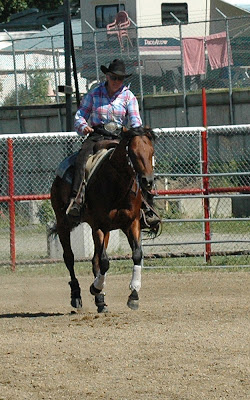The problem: The
horse makes no effort to stop when asked – he does not want to stop.
Why does this problem
happen? If a horse does not mentally ‘want’ to stop, he will not try to stop. There are several reasons
this might happen.
Note: Although all
horses are not capable of long, deep sliding stops, all horses can learn to
want to stop correctly and even slide two or three feet.
If horse will not try to stop from a trot or slow lope:
1. He is sore.
2. He is scared to stop.
3. The ground is “sticky” (This applies more to harder
stops)
4. He is not asked to stop with clear, consistent signals.
If horse is willing to slow-lope stop but will not try
long, sliding stops:
1. He is sore.
2. He does not have the ability to perform hard stops.
3. He is scared.
4. He is not shod correctly.
5. The ground is poor.
6. He is not asked to stop with clear, consistent signals
from his rider.
How to correct this
problem:
1. Is he sore?
Yes? If the horse is sore, he won’t want to stop. Abort
training until he is sound.
No? Look for another reason.
2. Does he have the
conformation to stop?
No? If the horse is not built to stop, he can’t do the job! Consider
another discipline.
Yes? Look for another reason.
Note: Conformation for
good stops: 1. Strong back (short) and loins. 2. Strong hind quarters with feet
that point straight ahead 3. Long sloped hip 4. Low hocks 5. Good withers (not
lower than hip) 6. Balanced 7. Athletic
3. Is he mentally
prepared to be schooled to stop? If the horse is mentally prepared, he has
been trained by slow step-by-step progressive training prior to intense stop training. He has not been frightened by
abusive training methods. Forcing a horse
to stop simply does not work to achieve the ultimate goal - long, correct,
pretty stops that score well in the show pen.
4. Is he shod
correctly? A horse must have sliding plates to learn to slide – tempered
flat bar iron at least one inch wide. Nail heads should be countersunk or filed
off to reduce friction and the toe rolled (front quarter of shoe curved up).
The sides of the sliding plate should come almost straight back to allow dirt
to flow out the back and the trailers should extend back to the bulbs of the
foot to protect the bulbs when he slides.
Note: I ask my farrier
to trim the foot naturally (same angle as pastern). When I start my horses
stopping, I usually use a narrower sliding plate until he gets used to the
feel. I might also let him wear the nails down himself on his first set of
sliders so he doesn’t scare himself.
5. Is the ground
suitable for sliding stops?
No? If the ground is wet, sticky or too deep, postpone hard
stops until another day and better ground.
Note: Although I can
school my horse to stop at a walk and jog on ground unsuitable for true
“sliding stops”, deep, hard stops should not be tried on anything but good
stopping ground.
Yes? If the ground is good (firm base with 2-3 inches of light
sand on top) and the horse has passed all of the above criteria but still does
not ‘want’ to stop, the rider can help with some simple exercises and a lot of
time and patience.
6. Clear, consistent
rider aids – There are two categories of horses that do not ‘want’ to stop
– horses that have not been trained with clear, consistent rider aids and
horses that are scared to stop (poor ground, soreness, rider abuse). Both need
the same thing – basic training to build confidence. If the horse is sound, is
built to stop, is not scared, has correct sliding plates on and good ground to
slide on, I can start building his confidence and hopefully, his desire to
stop.
Exercise: If I encourage my horse to like to stop, he will try
to stop. Everything about stop training is about making it a pleasant
experience (even more important if the horse has already learned to hate
stopping).
From the beginning, I teach my horses that “whoa” is a very
nice word. The way I do that is to rest him after he stops. If he doesn’t stop,
the only correction he gets is to repeat the exercise. If the horse has been
“punished” for not stopping or not stopping correctly, he learns to hate “whoa”
and the exercise. Naturally, all stops are not good but when my horse does not
stop well, the correction is “no reward (i.e. rest)”. Instead, I do it again.
If necessary, I lower the level of the maneuver to get a good stop so I can
reward him. I do the same thing with a scared horse that doesn’t try to stop
(prior abuse, poor ground or sore) but with that horse, there is a huge trust
issue. I must teach him to trust himself and me so that he wants to stop again.
Almost certainly this will have to be done at a lower level, a trot even. A
horse will not want to stop if the task has become unpleasant or hurtful. It
can be very difficult, but not impossible with a good rider, to rehabilitate a
horse that has been mentally hurt.
I prefer horses that are born with a desire to stop and most
of the horses I train now fit in this category. It’s up to me not to damage that desire.
 |
| This horse is demonstrating how much she loves to stop! |















